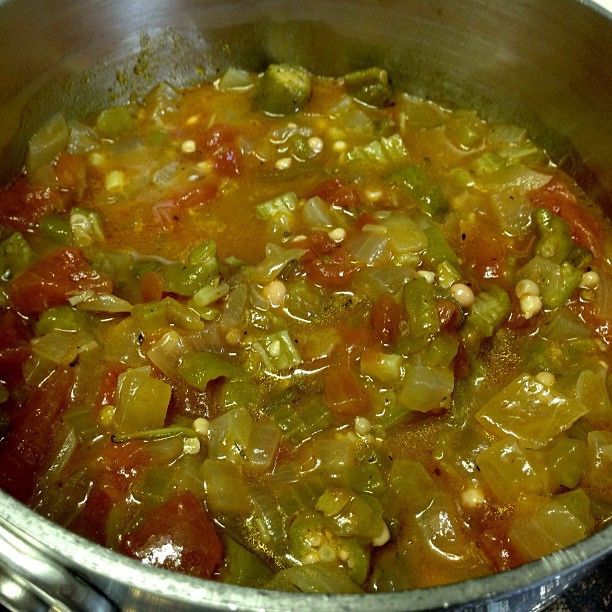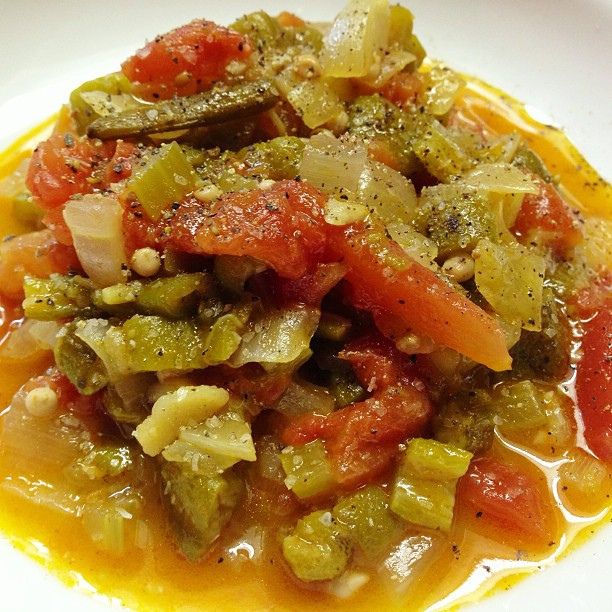Smothered Okra with Tomatoes and Onions

Okra and Conversion of the Heart (Sorta…)
When I was a kid, I hated okra. I would even pick it out of my gumbo and set it on a plate or a paper napkin. [Note: Paper is not the best option in that circumstance.] But my mother loved it, and my grandfather grew it in his garden. So okra was always a possibility on our summer menus, much to my dismay. My mother was particularly fond of fried okra. I loved just about anything fried, so you know I tried it. I didn’t like. Not at all. To me it tasted like licorice. And, in my book, only licorice was supposed to taste like licorice.
I am happy to say that things have changed.
I now eat okra in my gumbo. As a matter of fact, one of my favorite gumbos is Shrimp & Okra Gumbo. It’s easy to make, and it’s delicious in the summer when both shrimp and okra are in season.
I can’t say that I would normally opt for okra on any given day. Until now, that is.

My, How Things Change
Last summer, my wife made Smothered Okra & Tomatoes based on Emeril Lagasse’s recipes in Louisiana Real & Rustic. I remember tasting it. It was pretty good. She also fried okra last summer, just for fun. I ate that too. And I like it. I used okra several times in gumbo over the course of the fall and winter. But that was frozen okra we bought at the supermarket. I really only had fresh okra for the first time last summer… just to appease my wife.
Then, the other day, my wife asked me to pick up some fresh okra from the farmers market.
“OK….” was my hesitant response. I was wondering if I was going to be expected to eat it again. Funny how quickly we can forget some things.
“You loved it last summer when I smothered it with tomatoes.” she said.
“That’s right!” I said. “How could I forget that?”
So, off to the market I went, and fresh okra did I purchase.
As it turns out, I ended up making the same recipe that my wife made last summer: Smothered Okra with Tomatoes & Onions. This recipe is based on the one in Louisiana Real & Rustic, with a few modifications. It was the first time that I cooked okra kind of by itself, instead of just using it as a thickener in a gumbo. And guess what. I really, really like it.
I hope you like it too. Here’s the recipe…
INGREDIENTS
- 2 pounds okra, sliced with stems removed
- 4 small (or 3 medium) sweet yellow onions (preferably Vidalia), chopped
- 3 ribs celery, chopped
- 3 to 4 large Creole tomatoes (or any homegrown tomatoes), peeled and chopped
- 5 bay leaves
- 2 tablespoons organic coconut oil
- 2 tablespoons bacon grease
- Extra-virgin olive oil, as needed
- 2 teaspoons salt, or more to taste
- 1/2 teaspoon cayenne
- 1 teaspoon freshly ground black pepper
- 5 to 6 cloves of garlic, minced (or crushed in a mortar & pestle)
DIRECTIONS
- Preheat the oven to 350ºF.
- Wash the okra under cool water. Cut off the stems and slice each pod crosswise into rounds, as thinly or as thickly as you desire.
- Skin the tomatoes by scoring them across the base and gently dropping them – one at a time – into a pot of boiling water for 8 to 10 seconds. After you remove each tomato from the water, allow it to cool a bit. Then peel away the skin from the base. Chop the tomatoes and reserve them in a bowl.
- Chop the onions and mince (or crush) the garlic. Set aside.
- Heat a large heavy-bottomed stainless steel pot (not cast-iron!) over medium-high heat. Add the coconut oil and the bacon grease and mix. Then add the okra and stir well. Cook until lightly browned and no longer slimy, about 8 to 10 minutes.
- Add the onions, tomatoes, garlic, bay leaves, salt, pepper, and cayenne. Stir well. Cover with a tight-fitting lid and transfer pot to the pre-heated oven. Allow it to cook for 1 to 1 1/2 hours, or until all the veggies have softened. Remove the lid for the 15 to 20 minutes of cooking time. That will allow the extra liquid from the onions and tomatoes to cook down.
- Remove the bay leaves and serve immediately.
This dish can be served as a side or as a main dish (particularly in Lent or on Fridays throughout the year.